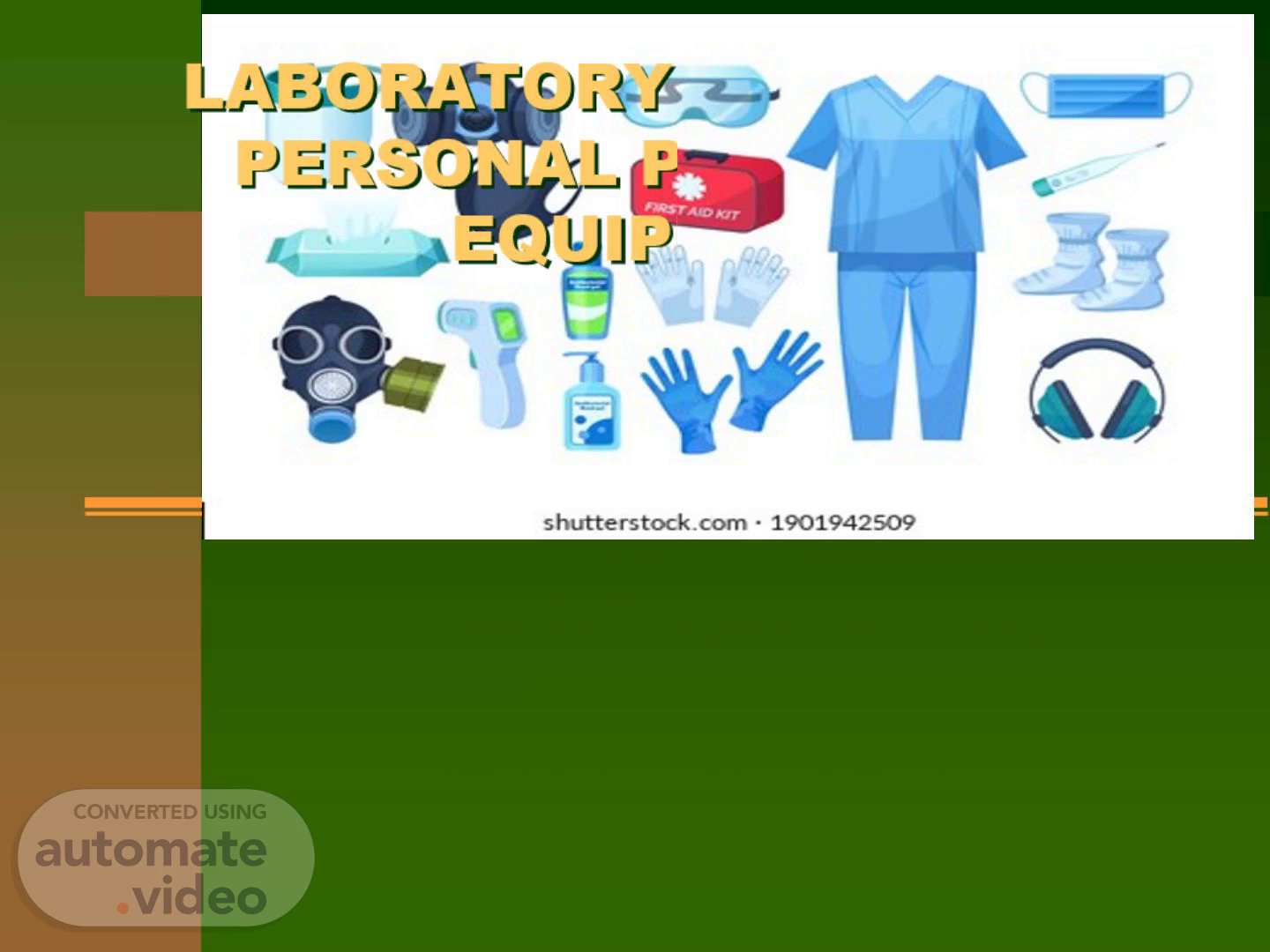Scene 1 (0s)
[image] medical personal protective equipment set 260nw 1901942509.
Scene 2 (10s)
AREAS TO COVER. General procedures or rules Glassware Equipment Safety equipment Personal protective equipment (PPEs) Electrical safety Disposal procedures Emergency response plans Inspections.
Scene 3 (20s)
TO PREVENT: adverse health effects from exposure to chemicals exposure to organisms, diseases, etc. in laboratories laboratory equipment hazards - if not maintained properly.
Scene 4 (33s)
Laboratory Policies and Procedures. [image] 8. Must be: written and available LABORATORY PROCEDURES MUST BE SITE SPECIFIC ! based on your lab needs, conditions, and equipment.
Scene 5 (45s)
no mouth pipetting individuals not allowed to work in the laboratory alone wear required personal protective equipment no smoking in laboratory maintain good housekeeping habits.
Scene 6 (56s)
GLASSWARE PROCEDURES. Storage Proper use Cleaning Cleaning up broken glassware Disposal of broken glassware.
Scene 7 (1m 6s)
[image] 10. [image] 9. Glassware Handling. Is this what your lab looks like?.
Scene 8 (1m 15s)
Glassware handling cont. Or does it look like this?.
Scene 9 (1m 23s)
proper labeling, including wastes proper storage storage cabinets store compatible chemicals together rooms properly vented & correct temperature.
Scene 10 (1m 34s)
Procedures for handling chemicals cont.. Maintain a current inventory Purchasing procedures Proper handling use label or MSDS never test by taste or odor acids poured into water never vice versa take precautions and use proper equipment when stirring or heating flammable liquids follow “industry standards” for labeling all chemicals.
Scene 11 (1m 51s)
[image] 13. [image] 12. Lab Equipment. Which picture represents a proper hood?.
Scene 12 (2m 0s)
Water baths Refrigerators Autoclaves Scales Hoods Centrifuges.
Scene 13 (2m 10s)
Handling and Using Lab Equipment. Proper installation Training on proper use Manuals or written procedures available Inspections Maintenance DOCUMENT.
Scene 14 (2m 21s)
proper equipment must be available requires training for the location so individuals know how and when to use equipment appropriately training on the correct maintenance & storage is also necessary.
Scene 15 (2m 34s)
SAFETY EQUIPMENT. FIRST AID AND MEDICAL TRT EMERGENCY EQUIPMENT SHOWERS, EYEWASH STATIONS MSDS’S PPE.
Scene 16 (2m 45s)
First aid kit available and properly stocked (nothing expired) Trained first aid attendant or Medical facilities within 15 minutes Emergency numbers posted.
Scene 17 (2m 57s)
Emergency Equipment. Fire blankets Fire extinguishers Emergency notification system Unrestricted means of communication Any other emergency equipment needed for your specific laboratory needs.
Scene 18 (3m 7s)
Emergency Showers and Eyewash Stations. must be available showers must be tested for proper operation with results documented.
Scene 19 (3m 18s)
Immediate washing of the skin and eye with generous amounts of water is the most effective first aid treatment for chemical burns (unless chemical reacts unfavorably to water-MSDS).
Scene 20 (3m 30s)
Material Safety Data Sheets, (MSDS). required for each chemical requires employee and student review must be accessable for employees/student.
Scene 21 (3m 42s)
MSDS Information Includes:. Nomenclature including chemical family and formula Hazardous ingredients Physical data Fire and explosion hazard Health hazard Spill and leak procedures Special protection information Storage and handling precautions.
Scene 22 (3m 53s)
Personal Protective Equipment. Proper selection and use of PPE is an important factor in the safe operation of laboratories. The Occupational Safety and Health Administration (OSHA) defines personal protective equipment (PPE) as "specialized clothing and equipment used to minimize exposure to hazards that cause serious workplace injuries and illnesses.".
Scene 23 (4m 9s)
Appropriate PPE:. aprons,lab coats gloves-latex,nitrile,neoprene goggles, face shields, safety glasses respirators-full, partial, dust mask noise protection.
Scene 24 (4m 22s)
[image]. [image] MAIN AREAS OF PROTECTION Click each button below to learn more about how PPE helps protect each area of the body from hazards. EYE & FACE PROTECTION RESPIRATORY PROTECTION BODY PROTECTION HANDPROTECTION FOOT PROTECTION.
Scene 25 (4m 33s)
Protection of employees and equipment inspect panels and plugs GFIs (specified by code) surge protectors inspection & reporting programs.
Scene 26 (4m 43s)
DISPOSAL PROCEDURES. chemical wastes organisms, diseases, animals glassware spills sharps.
Scene 27 (4m 52s)
DISPOSAL PROCEDURES CONT.. Trained persons designated to handle disposal Meet all required rules and regulations Proper collection containers Waste collection contracts Does not expose humans, animals, plants, etc upon disposal - may include decontamination, sterilization, incineration, autoclaving.
Scene 28 (5m 7s)
EMERGENCY RESPONSE PLAN. agencies should develop an emergency response plan BEFORE an emergency review with employees (students) make sure they understand the plan completely.
Scene 29 (5m 18s)
Emergency Response Plan should include:. recognizing emergencies lines of authority methods of communication safe sites and evacuation routes site security and control.
Scene 30 (5m 29s)
Emergency Response Plan should include cont.:. decontamination procedures provisions for medical treatment emergency alerting and response procedures PPE and emergency equipment for clean-up follow up.
Scene 31 (5m 40s)
INSPECTION OF LABORATORIES. Develop inspection report appropriate for laboratory cover all areas related to laboratory personnel practices operational practices equipment emergency protection equipment materials inventory miscellaneous.
Scene 32 (5m 51s)
THANK YOU ..
